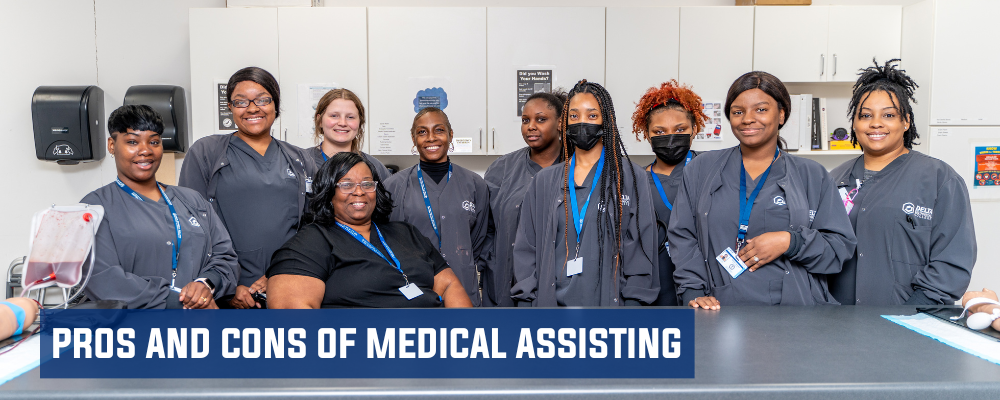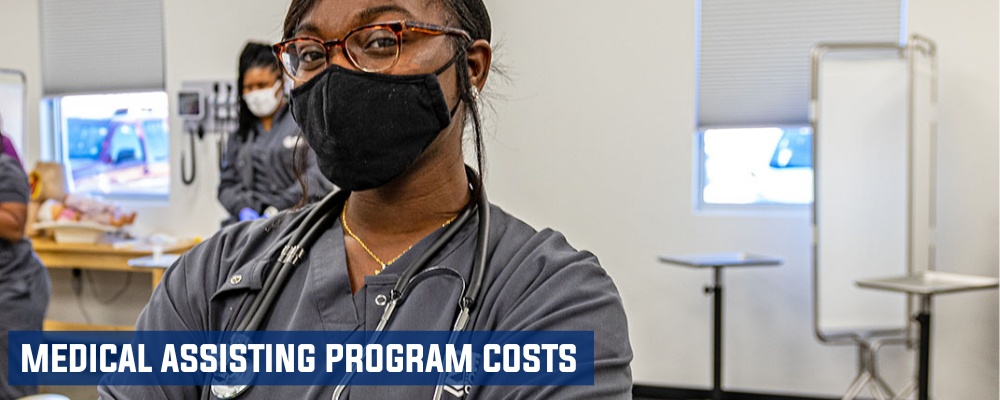A medical assistant is an allied health professional who performs administrative and clinical duties in a medical facility. Medical assisting duties may include scheduling appointments, updating medical records, taking vital signs, or prep a patient for physical exams.
Fortunately for those interested in a medical assisting career, the outlook for this field is considered excellent: the United States Bureau of Labor Statistics (BLS) predicts that employment of medical assistants will grow 14 percent through 2032. This is much faster than the national average of 3 percent for all other professions.
If a medical assisting career sounds appealing to you, you might be wondering what the pros and cons of this occupation are. Any career has advantages and disadvantages, and this is also true for medical assisting. Taking a closer look at the pros and cons associated with a career as a medical assistant may help you determine if this is the right job for you.
Pros of a Medical Assisting Career
The medical assisting career path has a lot to offer for individuals interested in a supporting role in allied health. This is especially true for those looking to work in a rapidly expanding industry, complete a short training program, and interact with different people, among other things. There are plenty of reasons to become a medical assistant.
Job growth
The medical assisting job outlook is much better than the national average of 4 percent. According to the BLS, projected employment growth for medical assistants is 14 percent. By all accounts, these qualified allied health professionals will remain very much in demand across 20232. The demand for medical assistants can in part be attributed to America’s rapidly aging population-particularly with baby boomers getting older. More people are in need of preventive medical services, which are typically provided by physicians. As a result, physician’s offices-where medical assistants usually work-will hire more assistants to serve these patients.
Short training
The educational requirements to become a certified medical assistant may provide students a shorter path to entering the workforce. U.S. News & World Report ranked medical assisting as the second-best job without a college degree in 2020. Aspiring medical assistants can enroll in an allied health career training program through a trade school that is much shorter than a traditional four-year college degree program. Students can obtain an associate degree from a community college program, which normally takes two years. Or, they can get a diploma from a vocational school (or community college), which usually takes less than a year. Delta Technical College’s medical assistant training program may be completed in nine months. This allows graduates to start looking for an entry-level job quite quickly.
Gaining expertise
Medical assistants have the opportunity to gain medical and technological expertise during their training and on-the-job. They learn medical terms, anatomy and physiology basics, office management skills, and keyboard techniques. Medical assistants can also follow the latest advances in the healthcare field, including new lab techniques and medical procedures.
Variety in job duties
The job duties of a medical assistant can be quite varied. Medical assistants typically perform both administrative and clinical tasks. Administrative responsibilities may be scheduling appointments, completing health insurance forms, processing billing and coding information, and greeting patients. Clinical duties can entail recording vital signs, taking medical histories, preparing patients for exams, drawing blood, or administering medications as directed by the physician. Each workday can look different.
Working with people
If you enjoy interacting with people, medical assisting may be a great career for you. You are part of a medical team, so you work with medical professionals like doctors, nurses, and other assistants. Of course, you also interact with patients when you greet them, prepare them for an exam or procedure, measure their vital signs, or draw their blood. You can help patients feel more at ease.
Clean work environment
Since medical assistants are employed by medical facilities, they work in hygienic environments. Physician’s offices in particular are clean and typically quiet. So, if you’re looking for a workplace that has a clean and calm atmosphere, medical assisting may be the right choice for you.
Specializations
Medical assistants can specialize in certain fields by enrolling in additional training. Specializations can include pediatric, psychiatric, or general medicine. Some medical assistants may also specialize in education. Specializations can help boost a medical assistant’s earning potential.
Medical Assistant Career Advancement
Medical assisting also has a number of career advancement opportunities. With sufficient experience, medical assistants can move into leadership roles. Some may also choose to obtain further education and advance into other medical professions like registered nurse, physician assistant, or nurse practitioner.
Cons of a Medical Assisting Career
Medical assisting also has a number of career advancement opportunities. With sufficient experience, medical assistants can move into leadership roles. Some may also choose to obtain further education and advance into other medical professions like registered nurse, physician assistant, or nurse practitioner.
Work Hours
Medical assistant work hours can fluctuate, introducing certain schedule considerations for some individuals. Allied health services are always in demand, meaning patients may require medical care at odd hours. Some medical assistants have to work evenings and weekends. Certain shifts can also be longer than traditional work hours. However, most medical assistants work regular schedules. While your hours will largely depend on where you work, recent BLS data indicates that medical assistants typically work full time. Although schedules may fluctuate based on seasonality and patient needs, the majority of medical assistants can secure full time employment.
Multiple Job Responsibilities
Due to the diverse needs of patients in their care, medical assistants may have several overlapping job responsibilities-how comfortable you are multitasking may influence your overall job satisfaction. Tasks like patient treatment, clinical procedures, and health assessment are mostly restricted to physicians, nurses, and other healthcare practitioners-becoming a certified medical assistant is one career path to help support these important services. If you want to perform any of these duties, you have to obtain further training, for example, as a nurse or physician assistant.
Working with needles
SOURCES
[1] https://www.bls.gov/ooh/Healthcare/Medical-assistants.htm#tab-6
[2] https://www.bls.gov/ooh/Healthcare/Medical-assistants.htm#tab-6
[3] http://www.medicalassistanttrainings.com/pros-and-cons-of-medical-assistant-job/
[4] https://www.onetonline.org/link/summary/31-9092.00#menu
[5] http://careers.alot.com/career-paths/the-pros-and-cons-of-a-medical-assistant-job-2061
[6] http://www.medicalassistanttrainings.com/pros-and-cons-of-medical-assistant-job/
[7] https://theemedicalassistants.com/pros-and-cons-of-being-a-ma/
[8] https://www.bls.gov/ooh/Healthcare/Medical-assistants.htm#tab-4
[9] http://careers.alot.com/career-paths/the-pros-and-cons-of-a-medical-assistant-job-2061
[10] http://www.medicalassistanttrainings.com/pros-and-cons-of-medical-assistant-job/
[11] https://www.bls.gov/ooh/Healthcare/Medical-assistants.htm#tab-2


